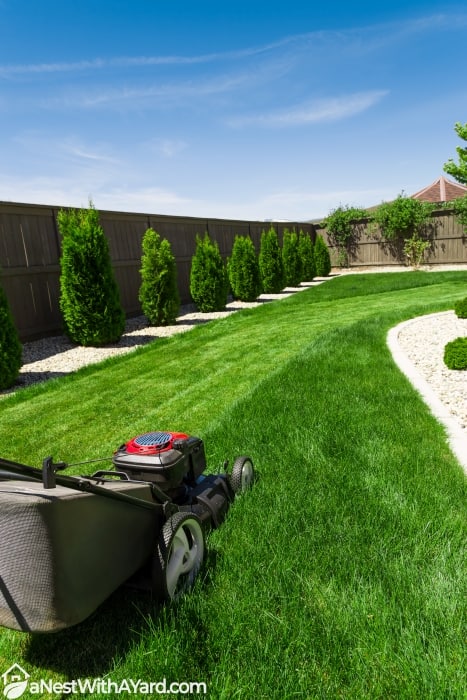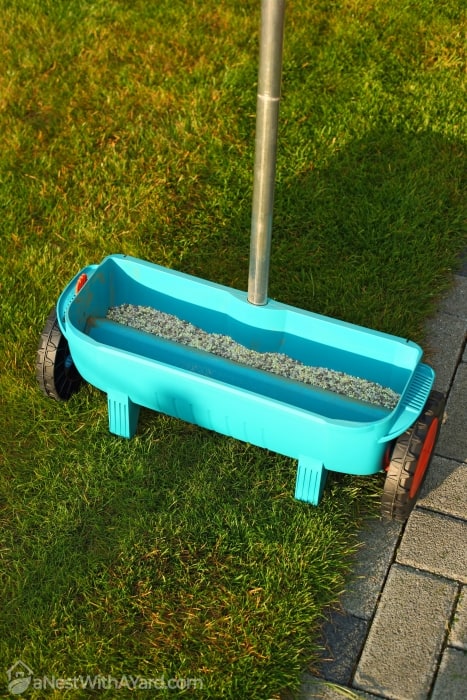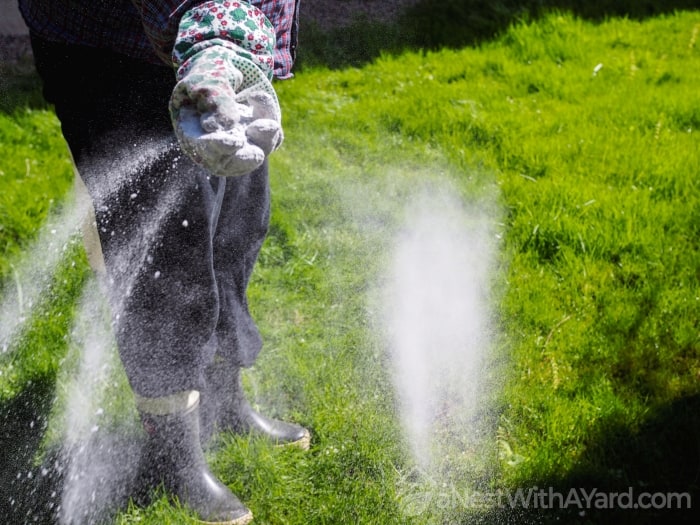It is suggested that you mow a couple of days prior to applying weed and feed and hold off a couple of days after applying it to mow again. This ensures there’s enough time for the herbicide to be absorbed into the weed leaves and start to work.
Weed and feeds contain herbicides and fertilizers. These products promote strong, healthy lawns and help to kill weeds at the same time, which are their intended outcomes. It is sometimes compared to the 2-in-1 shampoo and conditioners available, except for your lawn.
Weed and feed gives you a nice combination of killing your weeds while rejuvenating your lawn without killing it. While it is ultimately your decision when to mow your lawn, it is recommended that you allow a few days before and after you weed and feed before mowing.
Contents
- 1 What Does Weed And Feed Mean?
- 2 Mowing Before Or After Weed And Feed
- 3 When To Spread Weed And Feed
- 4 How To Apply Weed And Feed
- 5 Weed And Feed Types
- 6 Safety First
- 7 Why Isn’t My Weed And Feed Working?
- 8 Tips For Optimal Weed And Feed Results
- 9 FAQs
- 10 Ready To Weed And Feed Your Lawn?
- 11 About The Author
What Does Weed And Feed Mean?

There are a number of ways, both natural and chemical, that you can kill weeds. Weed and feed is one of these options. It is a combination of both a herbicide and a fertilizer and is considered to be both a simple and effective way to create a healthy lawn.
The weed portion refers to the part that is the herbicide, which is targeted at killing the weeds. It is not the same as a pre-emergent chemical. The herbicide is absorbed into the leaves of the weed and does not sit on the grass blades, which is why it doesn’t normally kill regular grass if it is applied correctly.
The feed part refers to the fertilizer, which will normally contain a combination of phosphorus, nitrogen and/or potassium, however, the combination will depend on which weed and feed you choose.
Mowing Before Or After Weed And Feed

If your grass is overgrown, you should definitely mow it before you apply weed and feed on your lawn. In general, though, you should make sure not to cut your grass too short. After you’ve applied your weed and feed, you should wait a minimum of 24 hours, but to be safe and depending on what product you’ve used, you should wait two days before you mow.
It is recommended that you mow your lawn a few days prior to applying your weed and feed and that you hold off for a few days after application before mowing again. This is because you want to allow time for the herbicide in your weed and feed to be absorbed into the weeds.
Waiting to mow after the application of weed and feed gives the weeds time to absorb the herbicides in the weed part of the product properly. If you cut your grass too soon after you’ve applied weed and feed, you could stop the spread of the weed-killing chemicals, resulting in the product not working as effectively as it should.
While the fertilizer aspect of your weed and feed is generally unaffected by mowing, the herbicide part of it can be. This is because the herbicide is absorbed through the leaves of the plants and mowing will remove a large part of the plants. So, applying weed and feed too soon after mowing could mean that there isn’t enough leaf area on the weeds to absorb the weed killer.
It can be ineffective if broadleaf weed control does not have enough of the plant to come into contact with. While the weed killer will eventually spread into the plant’s roots, it does so after being absorbed through the leaves.
When To Spread Weed And Feed

The best time for weed and feed application is in the spring, as this is when your grass begins to wake up from its winter dormancy and the weeds start to pop up all over.
You should refrain from applying weed and feed to newly seeded grass until after at least two mows. This is because weed and feed is too harsh for your new grass. It is also best not to put weed and feed down on any bare spots in your lawn that you have seeded, as the herbicide will stop the grass seeds from germinating.
It is recommended that you do not spread weed and feed more than twice a year. At a minimum, the amount of time you should wait between weed applications is two months.
While you can apply weed and feed again after two months, if your pesky weed problem isn’t solved in your first application in the spring, it is better to do the second application in the fall. This time gap is because you need to wait long enough between the applications to stop the chemicals from the weed and feed building up and killing the other plants in your yard.
To allow your weed and feed to work without it being washed away, you should apply it a few days before you expect it to rain. While moisture can help with the absorption of nutrients, it can also cause the ingredients to wash away if there is too much water. You should definitely check the weather forecast for the week you want to apply your weed and feed and only go ahead with the application if it’s going to be a rain-free week.
Should you find yourself with weeds popping up while your grass is dormant during the colder months, the best way to treat your lawn is through spot treatment. This entails you spraying just the weeds to kill them instead of using weed spray on the entire lawn.
How To Apply Weed And Feed

There are a number of things you need to consider when applying your weed and feed. Here are some of the steps you can follow when your lawn is ready for a weed and feed application:
- Apply weed and feed during the spring and fall. This is because it normally works best when the weeds are growing actively and when the temperatures during the day are between 60 degrees Fahrenheit and 90 degrees Fahrenheit.
- Mow your lawn anywhere between two to four days prior to applying it. If possible, you should try and cut your grass to a medium height, as this can help to make sure that the weed and feed is spread evenly over your lawn.
- Check the weather forecast for the week. You don’t want the rain to wash away your weed and feed before it is able to begin its work.
- Wet your lawn before applying. Spraying a light amount of water onto your grass will be beneficial, as you want it to be a little damp to help the weed and feed stick to the plants.
- Apply the weed and feed evenly. Using a spreader or spray applicator is likely the easiest option when it comes to ensuring you get an even layer of weed and feed. While you can apply granular weed and feed by hand, using a spreader will ensure a more even application of the product.
It is important to ensure that the weeds in your garden are actively growing. Applying your weed and feed during seasons where the weeds are not growing, like during the winter, will not help your lawn during the upcoming spring and summer.
If you don’t have weeds all over your yard, you can use a lawn fertilizer that does not contain a herbicide and treat those areas with weeds with a herbicide specifically designed for the type of weeds you have in those areas. This is because weed and feed over your entire lawn is only really necessary if there are weeds throughout your lawn.
All-purpose 10-10-10 lawn fertilizer is a good option for your lawn if your weed problem isn’t widespread. This fertilizer contains equal parts nitrogen, phosphorus and potassium and is good for plants that require a high amount of nitrogen. This lawn fertilizer is considered to be an excellent all-around fertilizer and gives your plants quick and instant nutrients.
If you’ve applied too much weed and feed, you will see your grass start to become dry and change color. To determine the right amount of weed and feed, you need to ensure you read the label on the product carefully and follow the instructions provided.
Check out this video by Solutions Pest & Lawn on YouTube for more information on how to use weed and feed fertilizers:
Weed And Feed Types
When making a decision on the weed and feed you want to purchase, you have two options concerning the type of herbicide it contains. The herbicide will either be a pre-emergent weed killer or a post-emergent weed killer.
Weed and feed with pre-emergent herbicides need to be applied earlier in the year as they prevent the weed seeds from germinating while ones with post-emergent herbicides work on weeds that are already growing, so they are better applied later in the year.
Pre-emergent weed killers help stop the germination of weed seeds, thus helping with weed control. When the weeds pop up, they hit the chemicals and die or they help before the weed even spouts by coating the seed shell.
To help the granules stick to the weeds better and have a better chance at releasing the herbicide, feed weed and feed that contains post-emergent herbicide in the early morning when there is dew on the grass or water your lawn before applying it. It is easier for the granules to stick to grass blades that are wet.
There are also two different types of weed and feed products: liquid and granular. For liquid weed and feed, it is recommended that you wait 24 hours to cut your grass after application of the product, while for the granular weed and feed it is recommended that you wait 48 hours to mow.
The difference in time between the two is because you want to ensure the granular product’s ingredients have had time to be absorbed and won’t end up being removed when you mow your lawn.
If your lawn has broadleaf weeds, such as Dandelion and Chickweed, treating them with a product that contains a selective herbicide that will affect and control the growth of broadleaf weeds is your best course of action. Weed and feed products are a good choice for this, as they are a simple and effective way to kill broadleaf weeds in your lawn.
Take a look at this video by North 40 Outfitters explaining some of the differences between pre-emergent and post-emergent herbicides:
Safety First

Make sure that you keep your children and pets off the lawn until your weed and feed dries, as the herbicides contained in the weed and feed can be harmful to humans and animals. Ensure that you also keep the weed and feed away from your edible plants.
Make sure to wear clothes that cover your skin, as well as safety goggles and a dust mask when working with weed and feed and mowing. After applying weed and feed, it is also best to wash all exposed skin and launder the clothing you used during the application.
Why Isn’t My Weed And Feed Working?
If you’re wondering why your weed and feed application just isn’t making a difference, there could be quite a few reasons. Here are some of the most common:
- You may not have selected the right product for your type of weeds. Weed and feed does not help against things like crabgrass and other grassy weeds, as it targets broadleaf weeds. To make sure that your weed and feed is going to be effective on your lawn, make sure the weeds you are wanting to get rid of are on the list that the chemical targets.
- You may not have applied it correctly based on the type of weed and feed you purchased. Weed and feed with post-emergent herbicides should be applied while the weeds are actively growing.
- If you’ve applied your weed and feed too late, it’s unlikely to be as effective. Once the ground has cooled down too much or has started to freeze, it is too late to apply weed and feed and expect it to be effective. It is best to use weed and feed on your lawn early in the growing season or a few days after mowing, as weeds that are mature are not growing and the weed and feed will likely not be as effective.
- If it has rained too soon after you’ve applied weed and feed, it is possible that a majority of your product was washed away, thus causing it to be ineffective. Ensure that there is no rain forecasted for the day you apply your weed and feed, as well as a few days after. This applies to watering your garden, as well.
Check out this video by Elite Lawn Care which answers the question of how soon you can mow your lawn after you’ve applied weed and feed treatments:
Tips For Optimal Weed And Feed Results
Here are a few things you can consider regarding weed and feed and its application:
Identify The Weeds
Figure out what type of weeds are growing in your lawn to make sure that when you decide on a weed and feed, the herbicide in it is targeted at the type of weeds you have in your lawn.
Read The Instructions Carefully
Make sure that you read the label of the weed and feed you want before purchasing it to make sure it’s the one that is the right fit for your lawn.
Identify The Grass Type
Identify the type of grass your lawn is to know when the best time to fertilize it would be as it is best to fertilize cool-season grasses during the fall but warm-season grasses in the spring or early in the summer.
Mowing Height
Mowing height makes a difference when it comes to your battle against those pesky weeds. You need to find a balance between too high as you could allow your weeds to mature and create seeds, and too low as you could damage your lawn and thus leave it vulnerable to more weeds.
You need to ensure that you are mowing your lawn at the right height for the type of grass you have. A majority of warm-season grasses should be maintained at a height of around one to two inches while cool-season grasses are normally maintained at a height of around one to two and a half inches.
You should try to make sure you do not remove over one-third of the grass when you cut it. If it has grown too high, you should cut it at a high setting and slowly lower it to the height you want over the next few mowings.
Lawn Clippings
If you have a severe weed infestation in your lawn, consider picking up all the lawn clippings after a cut to reduce the spread of weeds prior to your weed and feed. Having a clipping bag attached to your mower is also an option when mowing weeds. Weeds grow rapidly and collecting the clippings will help prevent mulching the seed heads back into the soil.
You will ultimately cut your grass again after your weed and feed as settled. When you mow your lawn again after the application there is no need to collect the weed and grass clippings as you did before the weed and feed. This is because you do not wish to waste any of the granules from the weed and feed that has not been absorbed by the weeds.
Allowing the clippings to remain on the lawn after your cut will ensure that as much product stays on your lawn as possible. The fertilizer side of the weed and feed will also receive a boost from the lawn clippings being mulched. These clippings will also help to hold in the newly applied nutrients giving your lawn more time to absorb them.
FAQs
Should I Mow Before Weed And Feed?
You should not mow directly before weed and feed. It’s better to cut a few days prior to applying weed and feed. In general, it’s okay for you to mow the lawn one or two days prior to application however each weed and feed product will have its own instructions.
Should I Mow Before Spraying Weed Killer?
You should not mow before spraying weed killer. It is recommended that you do not mow your lawn for a minimum of five days before spraying your weeds, as weed killers work best when they have a lot of leaves to be absorbed into.
How Soon Can You Weed And Feed After Mowing?
You can weed and feed one to two days after mowing. This is because weed control treatments are affected by mowing. If you mow your lawn right before treating it, there won’t be enough leaf area to absorb the weed killer.
Should You Fertilize Before Or After Cutting Lawn?
You can fertilize before and after cutting the lawn. In general, fertilization is not often affected by mowing, however, you should allow at least two days after mowing before you fertilize your lawn.
Ready To Weed And Feed Your Lawn?
Ultimately, it is important to give your weed and feed some time after application to activate, but the answer to your question is, yes you can mow your lawn both before and after applying weed and feed.
In both cases, you should wait a few days before and a few days after to do so. You should also try and make sure you pick a time when the weeds are actively growing. In the end, the choice is yours.
Are you ready to get rid of all those pesky weeds while feeding those important nutrients into your lawn?


